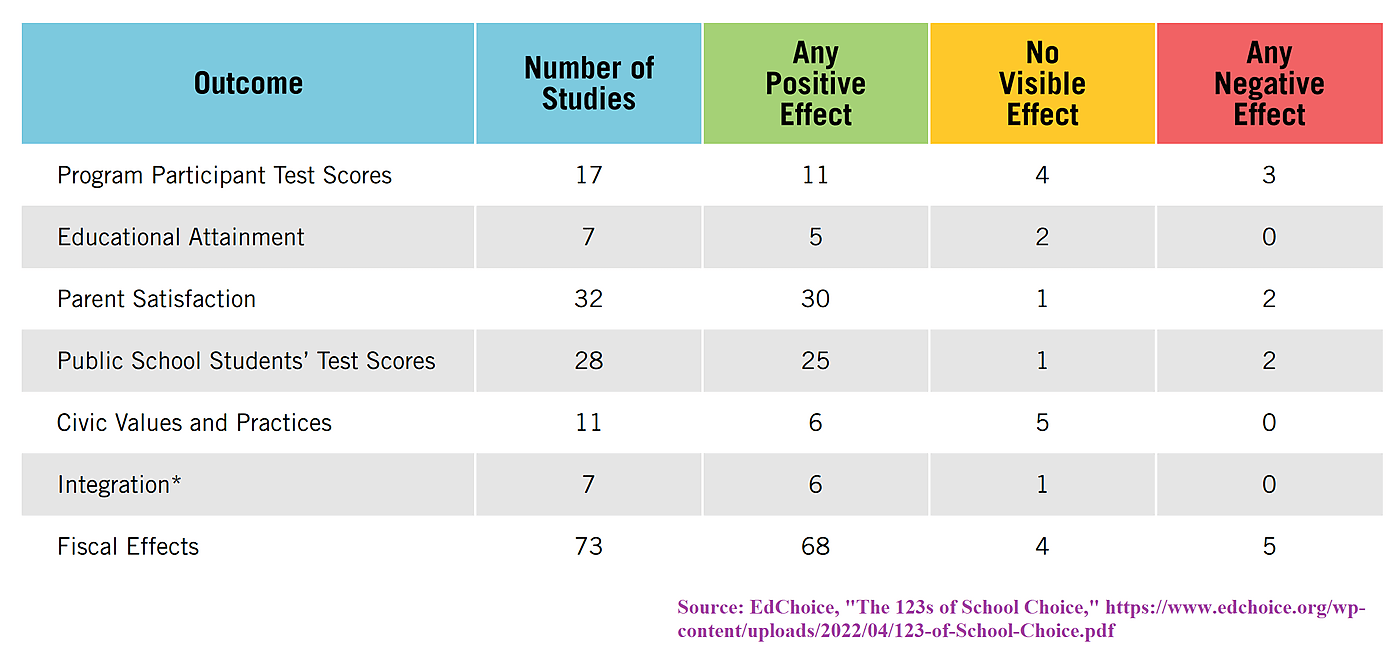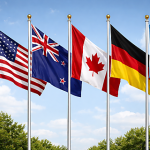
Neal McCluskey
The 1990 book Politics, Markets, and America’s Schools, by John Chubb and Terry Moe and published by the Brookings Institution, had a major role in school choice history, arguing that public schools are, by their democratically controlled nature, doomed to stagnation. Autonomous schools and choice for families, they convincingly explained, fundamentally change that. But the book contained one statement that still haunts the choice movement: We should see choice as a “panacea.”
Education funding following children to options their families choose, coupled with freedom for educators, is, indeed, a game‐changer, moving us from a system of government control to one grounded in free people, with diverse values, needs, and desires, making decisions. It is consistent with a free society and immediately moves significant power away from special interests and bureaucracies. That is why the explosion of school choice programs since the onset of COVID-19, and especially the arrival of universal programs, are extremely welcome developments.
But we must keep expectations grounded. Choice is not a panacea for everything people dislike about education. In part that is because choice does not decide how to teach, it simply frees people to try different approaches. It does not determine the best school discipline policy, it just helps families decide for themselves if they want no‐excuses, free‐range kids, or something in‐between. And there will likely be no single outcome indicator that everyone can point to demonstrate success or failure because we do not all agree on what constitutes success or failure.
The Expected Benefits of Choice
What do we expect to get from choice? First and foremost, more freedom – people with different values and desires are enabled to seek out education consistent with those things without having to defeat people who want something different. Families that want students able to choose the bathroom they use no longer have to defeat in political combat those who want access determined by biological sex. Those who want diversity, equity, and inclusion policies not having to politically thwart those who don’t. And so on.
Next, choice should put competitive pressure on schools to improve, because they must attract families to survive and thrive. The basic need for students should spur schools to try to get better at what they already do, and more importantly, to attract even more students—and funding—by finding better ways to educate.
Finally, choice should enable greater specialization, with some schools focused on artistic children, some on children with disabilities, some on kids who thrive in unstructured environments, and so on. Rather than having to try to serve all kids, which incentivizes aiming at the mythical “average,” or lowest‐common‐denominator content everyone will at least tolerate, educators can focus on the needs and desires of numerous subsets of real‐life, unique children.
What Does Universal Choice Look Like?
The big movement in school choice over roughly the last year has been toward universal education savings accounts (ESAs). “Universal” typically means there is no income cap or other curb on who qualifies for funding.
An ESA, universal or otherwise, is different from a voucher in that money is put into an account in a child’s name and the funds can be used not just for private school tuition, but typically also tutoring, therapies, or other educational uses. Unspent money can usually accumulate over time, including in some cases carried over for college. The amount per child in universal programs is generally around $7,500, which is less than half of the roughly $15,500 spent per American public school student.
Universal programs tend to have limited regulations, especially avoiding requirements that chosen schools administer state standardized tests. They often require that some standardized assessment be administered, but it need not be the state test that, especially if coupled with ramifications based on performance, would de facto require private schools to implement public school curricula. The programs also sometimes have a couple of ramp‐up years to reach full universality, including restricting access to students from specific groups, including those falling under income caps.
What Schools Will Be Chosen?
Annual allotments of $7,500 will not make famous private schools such as Exeter and Sidwell Friends affordable to most families, though they might help those on the margins of affording $50,000-plus tuition. But most private schools are not super‐pricey. They are relatively low‐cost, often religious, institutions. That’s why the average tuition nationwide is around $12,200—about $3,300 less than we spend per public school student. Also, many private schools, especially elementary, are $7,500 and below, making them affordable with just the annual ESA. And since many are below that, elementary ESA recipients could save money to use at more expensive high schools.
Will universal programs encourage fly‐by‐night operations? We have seen such schools in both higher education and K‑12, and unfortunately should expect some. That said, many private schools are quite old. Indeed, a big problem is that many well‐established schools have shut down or are on the verge of closing, struggling to survive against better‐funded “free” public schools. The average founding year for closed private schools on Cato’s Private Schooling Status Tracker is 1944.
While the existence of schools focused on money and not education is a real concern, we want supply to meet increasing demand. Part of that will be existing schools staying in business and expanding. Part will be new entrants, some of which will be of modest quality or worse (though, as we will discuss, what constitutes “quality” is hardly clear‐cut). But as choice becomes the norm, we should expect to see poor performers tending to go out of business and superior performers becoming more stable and expanding. We will also likely see more tools to help parents become savvy consumers, building on current resources such as GreatSchools and Niche. And don’t forget the alternative: public schools that frequently appear to get poor outcomes, often for more money.
But let’s not be too optimistic: While universal programs in at least six states providing roughly $7,500 per student beats the status quo, it will not be nearly enough to spur massive expansion of good choices, or transformative innovation. And as long as education is seen as something that should be nonprofit – in which providers should be satisfied to meet costs and educate small numbers of mainly local students – innovation will be stifled. Innovation involves risk, and trial and error, which requires funding. It also requires the ability to make a big financial return with success, both to compensate for risk and to spur imitators who, seeking to tap into the financial windfall, will bring innovations to scale and prices down.
What Does “Quality” Look Like?
Choice will likely bring some low‐quality providers into the market. But what constitutes “quality”? Is it high standardized test scores, especially on state tests? Instilling virtue? A strong sense of community? Other things?
The answer is that quality is in the eye of the beholder, and diverse people behold in myriad ways. When this is the case – when people value numerous things at many different levels – the way to determine whether a school is “quality” is not a single measure like test scores, graduation rates, or even a combination of those, but whether the school attracts and satisfies customers: families.
What do parents want from education?
A recent survey that required respondents to make tradeoffs among different priorities ranked both what parents and the general public value among 57 educational “goods.” For parents, the top priority was that “students have the option to choose the courses they want to study based on interests and aspirations.” They also wanted students to be “able to think critically to problem solve and make decisions” and to “develop practical skills” such as managing “personal finances.” The fifth highest priority was “students demonstrate character” such as “honesty, kindness, integrity, and ethics.” The general public had similar priorities.
Practical skills and developing unique, virtuous people ranked at the top of the priority lists. Meanwhile, for both parents and the general population, standardized test scores ranked 49th – near the bottom. Importantly, that option qualified such tests as being used to rank students against each other, but we’ve seen low prioritization of standardized tests before.
Emphasizing diversity, the survey found priorities differed by race and ethnicity. For instance, Asian members of the general population placed students having “the option to choose the courses they want to study based on interests and aspirations” as their top priority, while Hispanic and Black respondents placed it 52nd. Black respondents put students advancing “once they have demonstrated mastery of a subject” number 2, while Asians and Hispanics put it 28th. Of course, race/ethnicity is just one of the countless ways American are diverse.
Standardized Test Scores
Standardized test results are not necessarily high on the priority list for parents. But let’s set that aside for a moment. What do we know about choice and test scores?
On the whole, the top‐quality research – random assignment of students to receive choice funds – tends to show a test‐score benefit, but small and typically in older studies. Newer random‐assignment studies show substantial negative effects in Louisiana, and one shows no effect in Washington, DC.
There are also studies using less rigorous approaches that have found negative impacts, though with important caveats. For instance, in an Ohio study, the researchers noted that they could “only credibly study the performance effects of moving to private schools…for those students leaving comparatively high‐achieving public schools.” They went on, “It may be the case that there are less negative, or even positive, performance effects for students moving to private schools from lower‐performing public schools.”
An Indiana study looked only at low‐income, upper‐elementary, and middle‐school students and only found negative impacts in math. It found no effects in reading. It statistically matched choosers and public school remainers, and the authors noted, “Because we specifically focused on the lowest income voucher students who transitioned from a public to a private school, our analysis represents only a partial effect of the voucher program on student achievement…effects may differ for all other voucher students.”
The research is far from conclusive that choosers end up with worse standardized test results than comparable students who remain. But if you value standardized test scores, these findings are a reason to temper your enthusiasm about the growth of school choice.
Importantly, this might reflect less testing focus, not less learning. Private schools long had less incentive to care about standardized tests than public, especially state tests that were the crux of public‐school accountability during the No Child Left Behind era from 2002 to 2015. Private schools might not have drilled on testing strategies such as if you can eliminate two answers it is worth guessing, or knowing that there will always be a math problem with two trains heading towards each other at different speeds.
Finally, if there is one thing that has been consistently replicated in school choice research, it is that competition incentivizes public schools to improve their testing outcomes. That does not explain all relative “loss” for choosers, but choice may well help lift all boats.
Non‐Test Outcomes
The primacy of math and reading tests in public schools under NCLB appeared to crowd out time for other subjects, while private schools might have maintained them. That crowd‐out may have ultimately been damaging even if test scores rose, with some research indicating that standardized test scores do not reliably translate into long‐term outcomes many people value, such as educational attainment, lifetime earnings, and health.
This is consistent with research that finds many advantages for private school choice outside of standardized testing. For instance, studies have repeatedly found private school advantages in producing knowledgeable, tolerant citizens. Research has found a choice advantage in moving students to high school graduation and college. And perhaps most important given how we judge quality when people want diverse things, 30 of 32 studies have found positive parental satisfaction effects for choice, versus only 2 finding negative impacts.
Who Will Choose?
As universal programs have arrived, a major objection has been that enrollment in expansive choice programs has primarily consisted of families already using private schools. Indeed, some choice opponents have suggested that choice is really about helping “the rich,” not the needy.
For context, the vast majority of school choice programs are targeted at low‐to‐middle‐income families, kids in poorly performing public school districts, or students with disabilities. Populations facing specific challenges, not the privileged few, have long been the focus of school choice efforts. Of course, by definition, universal programs encompass all families.
No matter what the intent, it should be no surprise that the first people to sign on to universal choice tend to already use private schools. They are likely to be among the first to hear about such programs and most able to immediately use them. And it is no more just for them to pay twice for education – once for public schools they do not find acceptable, a second time for education they do – than anyone else.
Over time, we should expect already private‐schooling families to become smaller shares of the new‐enrollee population, as people not already in private educational arrangements become more aware of the programs. We already see such movement in Arizona’s universal ESA, enacted in mid‐August 2022. An early October 2022 report found that 80 percent of enrollees “did not have a record of prior public‐school enrollment.” Many were probably already using private schools, though some were also likely kids entering preschool, kindergarten, or first grade, with no previous K‑12 schooling at all. Fast forward to February 2023, and the not‐previously‐in‐public‐school share had fallen to 51 percent.
Not only do choosers trend away from current private school enrollees over time, there is no evidence that most current enrollees are rich. Income data for enrollees is not available, but as noted before, most private schools are not priced beyond most families’ means. We can also estimate private school enrollment shares by income. In 2018, researchers found that about 16 percent of families with elementary‐aged children in the top 10 percent of income used private schools, about 7 percent of students from 50th percentile families did, and 4 percent of the bottom ten percent did. Assuming the middle‐income rate applies broadly to families in the middle 80 percent of earners, approximately 80 percent of private schoolers are not rich, if “rich” is defined as being in the top 10 percent of earners. And, of course, $7,500 means a lot more to low‐income families than wealthy.
Again, though, we must be realistic. It is difficult to spread the word about new programs, and lower‐income families might not have as much familiarity with private school options as higher‐income. They might also have bigger transportation barriers. For these and other possible reasons, choice will likely not spread like wildfire to low‐income families.
Looking beyond income, choosers are almost certainly more likely to be religious than non‐choosers. Why? Because public schools are, constitutionally, supposed to be secular, making them unacceptable or compromised for many religious families. Indeed, about two‐thirds of all private K‑12 schools are religiously affiliated in large part because the public schools cannot be religious. And when they were religious they were unacceptable to some religious groups, especially Roman Catholics.
Conclusion: Freedom is Crucial, But Does Not Do the Work
In a free society, millions of diverse families and educators should decide amongst themselves what is the best education, not have that answer dictated by the government. That – freedom – is the core reason to champion choice. It is also a major reason that choice cannot be a panacea: people do not even agree on the disease. And choice itself creates no cures – it develops no pedagogy, establishes no discipline policies, and cooks no school meals. What it does is keep some people’s idea of a cure from being imposed on everyone else, and fosters the creation of options that meet the many wants and needs of diverse children, families, and communities.






